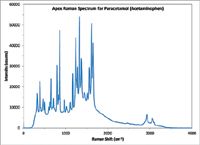Eliminating the Trade-Off Between Resolution and Throughput in Raman Spectroscopy
Application Notebook
Although Raman spectroscopy is an excellent analytical tool, Raman signals are often weak and traditional slit spectrometers typically have poor optical throughput, limiting their effectiveness in low light level setups.
Although Raman spectroscopy is an excellent analytical tool, Raman signals are often weak and traditional slit spectrometers typically have poor optical throughput, limiting their effectiveness in low light level setups. Using a high throughput virtual slit design, the Apex 785 Raman spectrometer from Ocean Optics eliminates trade-offs between sensitivity and resolution.
Conventional spectrometers use a narrow entrance slit to achieve high resolution, but at the expense of throughput. The slit can reject as much as 75–95% of the light entering the optical bench. With high-throughput virtual slit (HTVS) technology licensed from Tornado Spectral Systems, Apex spectrometers overcome the compromise between throughput and spectral resolution.
Apex uses a beam reformatting technology that eliminates the need for a physical slit to achieve high resolution. When combined with precision optical coatings, volume phase holographic (VPH) gratings, and solid state detector technology, spectrometer throughput as high as 95% is achievable.
Also, Apex spectrometers use a large input aperture and specially configured optical components to compress, reformat, and then expand the light beam, which narrows the input aperture along the dispersion axis while preserving total flux.
Experimental Conditions
To maintain peak optical throughput, Apex uses a 1200 line/mm VPH grating blazed at 830 nm in an optical bench with an uncooled, NIR enhanced back-thinned CCD array detector.
Raman measurements of paracetamol (acetaminophen), polystyrene, isopropanol, and toluene were made using the Apex spectrometer (APEX-RAMAN-785) in a setup with a 100 mW 785 nm laser diode, a Raman sample holder and a 785 nm Raman fiber optic probe. Integration time intervals ranged from
195 ms for toluene to 750 ms for paracetamol.
Results
As shown in Figure 1, the Apex measures spectral data over a Raman shift range beyond 3800 cm-1 with high spectral density, delivering Raman data with more spectral features for better library matching and sample identification. Also, the Apex spectrometer enables the acquisition of high quality Raman spectral data at very short integration times.

Figure 1: This Raman spectrum for paracetamol was acquired at 750 ms integration time.
Typical Raman measurements require seconds to achieve similar signal levels. This rapid measurement speed enables measurements in process flows and for samples that change over time. The low integration times required for the Apex also allow for the measurement of multiple samples in the time it takes to obtain one spectrum from a less sensitive spectrometer. This provides the opportunity for signal averaging to increase SNR, further improving measurement accuracy.
Conclusions
A new spectrometer design based on HTVS optical slicer technology has been shown to provide a significant increase (a factor of 10–15×) in optical throughput without any detriment in optical resolution. In addition, the technology allows users to achieve high sensitivity without the need for long integration times, detector cooling, or high powered excitation sources; to use shorter measurement times for faster measurements; to acquire more accurate spectral signatures; and to use lower power excitation sources to minimize photodegradation.
References
(1) Tornado Spectral Systems contributed to this application note.
Ocean Optics
830 Douglas Avenue, Dunedin, FL 34698
tel. (727) 733-2447, fax (727) 733-3962
Website: www.OceanOptics.com

Thermo Fisher Scientists Highlight the Latest Advances in Process Monitoring with Raman Spectroscopy
April 1st 2025In this exclusive Spectroscopy interview, John Richmond and Tom Dearing of Thermo Fisher Scientific discuss the company’s Raman technology and the latest trends for process monitoring across various applications.
A Seamless Trace Elemental Analysis Prescription for Quality Pharmaceuticals
March 31st 2025Quality assurance and quality control (QA/QC) are essential in pharmaceutical manufacturing to ensure compliance with standards like United States Pharmacopoeia <232> and ICH Q3D, as well as FDA regulations. Reliable and user-friendly testing solutions help QA/QC labs deliver precise trace elemental analyses while meeting throughput demands and data security requirements.